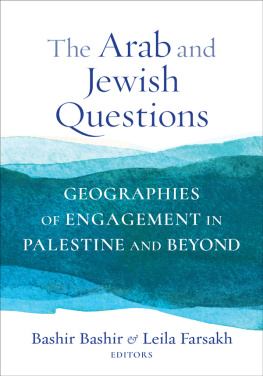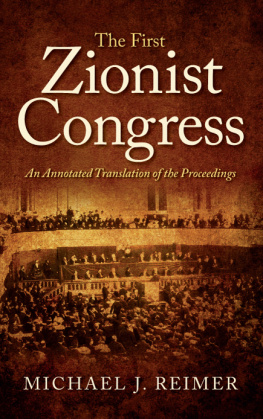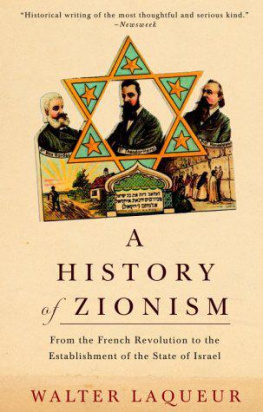ZIONISM IN AN ARAB COUNTRY
Jews in Iraq in the 1940s
ZIONISM IN AN ARAB COUNTRY
Jews in Iraq in the 1940s
ESTHER MEIR-GLITZENSTEIN
Foreword
ANITA SHAPIRA

First published 2004 by Routledge 11 New Fetter Lane, London EC4P 4EE
Simultaneously published in the USA and Canada by Routledge 29 West 35th Street, New York, NY 10001
Routledge is an imprint of the Taylor & Francis Group This edition published in the Taylor & Francis e-Library, 2005.
To purchase your own copy of this or any of Taylor & Francis or Routledges collection of thousands of eBooks please go to http://www.ebookstore.tandf.co.uk/.
Copyright 2004 Esther Meir-Glitzenstein
British Library Cataloguing in Publication Data Meir-Glitzenstein, Esther Zionism in an Arab country: Jews in Iraq in the 1940s 1. JewsIraqHistory20th century 2. ZionismIraqHistory20th century 3. JewsMigrations I. Title 956.7004924
ISBN 0-203-34406-5 Master e-book ISBN
ISBN - (Adobe e-Reader Format)
ISBN 0-7146-5579-1 (hbk)
Library of Congress Cataloging-in-Publication Data Meir-Glitzenstein, Esther. [Tenuah ha-Tsiyonit vi-Yehude Irak, 19411950. English] Zionism in an Arab country: Jews in Iraq in the 1940s/Esther Meir-Glitzenstein foreward, Anita Shapira. p. cm. Rev. translation of: Tenuah ha-Tsiyonit vi-Yehude Irak, 19411950. includes bibliographical references and index. 1. Jews-History-20th century. 2. Zionism-Iraq. 3. Iraq-Ethnic relations. 4. Palestine-Emigration and immigration-History-20th century. 5. Iraq-Emmigration and immigration and History-20th century. I. Title. DS 149.5.I72M4513 2004 956.7004924dc22 2003062611
All rights reserved. No part of this publication may be reproduced, stored in or introduced into a retrieval system or transmitted in any form or by any means, electronic, mechanical, photocopying, recording or otherwise, without the prior written permission of the publisher of this book.
Dedicated with love to my mother, Tzivya ne Hacham, and my late father, MordechaiGlitzenstein
Acknowledgements
The first version of this book was published in Hebrew by Am Oved Publishers and Tel Aviv University in 1993, and it was based on a doctoral dissertation written in Tel Aviv University under the supervision of Professor Anita Shapira. The changes that have occurred in Zionism historiography since the book was published, new research studies on Israel and the Jews in Islamic countries, my own recent research on the subject, and new insights that I have gained, prompted me to take another look at the book and at its structures and main theses. I changed the structure of the book, shortened it, added new chapters and updated it.
I would like to thank the Koret Foundation in San Francisco for its generous assistance and also the Iraqi Jews Educational Development Fund in Israel, especially Mr Oved Ben-Ozer.
I owe thanks to Professor Avishai Braverman, the president of BenGurion University; and to the rector, Professor Nahum Finger. I also owe thanks to Dr Ofer Shiff, the director of the Ben-Gurion Research Center at Sde Boker Campus, and to Dr Tuvia Friling, the former director, without whose assistance this book could not have been published.
List of Illustrations
An alley in the Jewish Quarter in Baghdad.
King Faisal I.
The Jewish senator, Menahem Daniel.
Rabbi Sasson Kadoorie, the president of the Jewish community.
The famous lawyer, Yosef el-Kabir.
Abraham el-Kabir, the director-general of the Treasury.
Enzo Sereni, the founder of the Hehalutz movement in Iraq.
The family of Rahamim Sehayek. The first emissaries lived in the family house.
Some members of the Hehalutz movement in Basra,1943
Abicycle excursion in Baghdad.
Members of the Aliyah Committee in Basra, 1950
Zionist activists (from left to right): the emissaries, Shmuel Moriya and Shlomo Hillel, and the wireless operator, Eliyahu Shani.
Zionist emissaries in Iraq, 1950. Standing (from left to right): Naim Bekhor, Yerahmiel Asa, Yoav Goral. Kneeling: Mordechai Ben Porat and Rafael Zurani.
All photographs are courtesy of the Babylonian Jewry Heritage Center, Or-Yehuda.
List of Abbreviations
Foreword
The story of Iraqi Jewry in the twentieth century is both typical and exceptional: on the one hand, the processes of modernization, Westernization, emigration and resettlement were the predominant features in Jewish life in that tumultuous century; on the other hand, the case of Iraqi Jewry is distinguished by the almost total uprooting undergone by that ancient community within an extremely short period of time. The whole process took less than ten years, from the shock waves created by the anti-Jewish pogrom, the Farhud in summer 1941 to the mass emigration to Israel in 1950. The intensity of the events makes Iraqi Jewry a fitting case study for exploring and understanding similar processes in other countries in the Middle East and elsewhere that were affected by the rise of militant nationalism, which had repercussions on the status of religious and ethnic minority groups. The rejection of the Jews by the nationalist Iraqi society sparked an identity crisis and a search for an alternative to Iraqi nationalism, eventually leading them to embrace Zionist ideology and depart from their homeland to Israel.
The encounter between the Zionist establishments desire to foster Jewish immigration to Palestine, and then to Israel, and the Iraqi Jews quest for identity is the topic of this book. Based on primary sourcesZionist, Israeli, Britishthis is a sophisticated study that tells the story from the point of view of both the Iraqi Jewish community and the Zionist and Israeli institutions. It is an important and most welcome addition to the growing literature on the process of modernization experienced by Jews in Middle Eastern countries and its connection with European rule in those lands. It also demonstrates most vividly the ambiguities and inner contradictions inherent in Zionist ideology and practice: oscillating between two self-imagesthat of the saviour of Jews from persecution, which entailed their mass immigration, and that of a renaissance movement, aimed at creating a new Jew and an ideal Jewish society, which entailed changing the immigrants and imposing upon them a foreign culturethe Zionist movement found itself acting at cross-purposes.
Seen from a contemporary perspective, the integration of Iraqi Jewry in Israeli society is a success story This, however, should not lead us to forget the mistakes that were made, the stereotypes that existed, and the pain inflicted by uprooting and resettlement. In this book, Esther Meir-Glitzenstein thus presents an ambiguous and multi-layered reality, as indeed history always is.
Anita Shapira
2003
Preface
The 1940s was a fateful time for Iraqi Jewry. Around the end of the period, from 1949 to 1951, more than 123,000 Jews left Iraq for Israel. The remainder, fewer than 10,000, left gradually; today only a few Jews remain.
This emigration was part of a more general wave of Jewish migration from Middle Eastern and North African countries to the West. The wave of migration began in the nineteenth century, most significantly with the migration of Syrian Jews to South America, and culminated after World War II with mass emigration from Egypt, Iran, Yemen, Turkey, Syria, Lebanon, Libya and Iraq.








